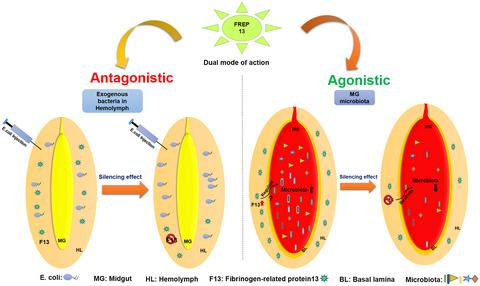当前位置:
X-MOL 学术
›
Immunol. Cell Biol.
›
论文详情
Our official English website, www.x-mol.net, welcomes your feedback! (Note: you will need to create a separate account there.)
Hemocyte-specific FREP13 abrogates the exogenous bacterial population in the hemolymph and promotes midgut endosymbionts in Anopheles stephensi.
Immunology and Cell Biology ( IF 4 ) Pub Date : 2020-07-05 , DOI: 10.1111/imcb.12374 Charu Chauhan 1, 2 , Tanwee Das De 1 , Seena Kumari 1, 2 , Jyoti Rani 1 , Punita Sharma 1 , Sanjay Tevatiya 1, 2 , Kailash C Pandey 1 , Veena Pande 2 , Rajnikant Dixit 1
Immunology and Cell Biology ( IF 4 ) Pub Date : 2020-07-05 , DOI: 10.1111/imcb.12374 Charu Chauhan 1, 2 , Tanwee Das De 1 , Seena Kumari 1, 2 , Jyoti Rani 1 , Punita Sharma 1 , Sanjay Tevatiya 1, 2 , Kailash C Pandey 1 , Veena Pande 2 , Rajnikant Dixit 1
Affiliation

|
The immune blood cells “hemocytes” of mosquitoes impart a highly selective immune response against various microorganisms/pathogens. Among several immune effectors, fibrinogen‐related proteins (FREPs) have been recognized as key modulators of cellular immune responses; however, their physiological relevance has not been investigated in detail. Our ongoing comparative RNA‐sequencing analysis identified a total of 13 FREPs originating from naïve sugar‐fed, blood‐fed, bacterial challenged and Plasmodium vivax–infected hemocytes in Anopheles stephensi. Transcriptional profiling of the selected seven FREP transcripts showed distinct responses against different pathophysiological conditions, where an exclusive induction of FREP12 after 10 days of P. vivax infection was observed. This represents a possible role of FREP12 in immunity against free circulating sporozoites and needs to be explored in the future. When challenged with live bacterial injection in the thorax, we observed a higher affinity of FREP13 and FREP65 toward Gram‐negative and Gram‐positive bacteria in the mosquito hemocytes, respectively. Furthermore, we observed increased bacterial survival and proliferation, which is likely compromised by the downregulation of TEP1, in FREP13 messenger RNA–depleted mosquito hemolymph. In contrast, after blood‐feeding, we also noticed a significant delay of 24 h in the enrichment of gut endosymbionts in the FREP13‐silenced mosquitoes. Taken together, we conclude that hemocyte‐specific FREP13 carries the unique ability of tissue‐specific regulation, having an antagonistic antibacterial role in the hemolymph, and an agonistic role against gut endosymbionts.
中文翻译:

血细胞特异性 FREP13 消除了血淋巴中的外源性细菌群,并促进了史蒂芬氏按蚊中的中肠内共生体。
蚊子的免疫血细胞“血细胞”赋予针对各种微生物/病原体的高度选择性免疫反应。在几种免疫效应物中,纤维蛋白原相关蛋白 (FREP) 已被认为是细胞免疫反应的关键调节剂。然而,尚未详细研究它们的生理相关性。我们正在进行的比较 RNA 测序分析确定了总共 13 种 FREP,这些 FREP 来自史蒂芬氏按蚊中的初始糖喂养、血液喂养、细菌攻击和间日疟原虫感染的血细胞。选定的 7 个 FREP 转录本的转录分析显示出针对不同病理生理条件的不同反应,其中间日疟原虫10 天后独家诱导 FREP12观察到感染。这代表了 FREP12 在针对游离循环子孢子的免疫中的可能作用,需要在未来进行探索。当在胸部注射活细菌时,我们观察到 FREP13 和 FREP65 分别对蚊子血细胞中的革兰氏阴性菌和革兰氏阳性菌具有更高的亲和力。此外,我们观察到在 FREP13 信使 RNA 耗尽的蚊子血淋巴中细菌存活和增殖增加,这可能受到 TEP1 下调的影响。相比之下,在喂血后,我们还注意到 FREP13 沉默的蚊子肠道内共生体的富集显着延迟了 24 小时。总之,我们得出结论,血细胞特异性 FREP13 具有独特的组织特异性调节能力,
更新日期:2020-07-05
中文翻译:

血细胞特异性 FREP13 消除了血淋巴中的外源性细菌群,并促进了史蒂芬氏按蚊中的中肠内共生体。
蚊子的免疫血细胞“血细胞”赋予针对各种微生物/病原体的高度选择性免疫反应。在几种免疫效应物中,纤维蛋白原相关蛋白 (FREP) 已被认为是细胞免疫反应的关键调节剂。然而,尚未详细研究它们的生理相关性。我们正在进行的比较 RNA 测序分析确定了总共 13 种 FREP,这些 FREP 来自史蒂芬氏按蚊中的初始糖喂养、血液喂养、细菌攻击和间日疟原虫感染的血细胞。选定的 7 个 FREP 转录本的转录分析显示出针对不同病理生理条件的不同反应,其中间日疟原虫10 天后独家诱导 FREP12观察到感染。这代表了 FREP12 在针对游离循环子孢子的免疫中的可能作用,需要在未来进行探索。当在胸部注射活细菌时,我们观察到 FREP13 和 FREP65 分别对蚊子血细胞中的革兰氏阴性菌和革兰氏阳性菌具有更高的亲和力。此外,我们观察到在 FREP13 信使 RNA 耗尽的蚊子血淋巴中细菌存活和增殖增加,这可能受到 TEP1 下调的影响。相比之下,在喂血后,我们还注意到 FREP13 沉默的蚊子肠道内共生体的富集显着延迟了 24 小时。总之,我们得出结论,血细胞特异性 FREP13 具有独特的组织特异性调节能力,


























 京公网安备 11010802027423号
京公网安备 11010802027423号